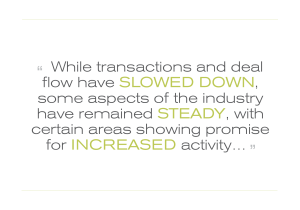Environmental Due Diligence: The Path Forward – Summary of our Panel Discussion May 12
 by ERIS STAFF
by ERIS STAFF
May 20, 2020
Click here for the audio recording
As Canada begins to loosen restrictions related to COVID-19 and reopen more businesses, environmental professionals involved in due diligence must carefully navigate the new normal amid uncertainties about the timeline for recovery and how they can return to operations safely to protect the health of employees and clients.
During an ERIS-sponsored webinar May 12, panelists discussed the general decline in the market due to COVID, and specifically noted a slowdown in transactional and due diligence work. Where work has continued, figuring out how to operate safely has been a paramount concern and appears to be one of the greatest challenges facing the industry going forward.
Panelists included: Vico Paloschi, Executive Vice President, GTA Services, Pinchin Ltd; Raymond Wong, Vice President, Data Operations, Data Solutions, Altus Group; John Georgakopoulos, Partner, Certified Specialist in Environmental Law, Willms & Shier Environmental Lawyers LLP; and Marty Barons, Contaminated Lands Team Lead, Environmental Engineer, WSP Canada.
Market Trends, Growth Areas
While transactions and deal flow have slowed down, some aspects of the industry have remained steady, with certain areas showing promise for increased activity. Raymond Wong with Altus Group, said its data group, which provides residential and commercial information, has never been busier. Because people are trying to figure out what is happening in the marketplace, Altus is running data almost on a live basis to get the trends. “Indicators show that commercial investment activity remains strong,” he explained, with $4 billion in investment in the Toronto-area compared to $4.1 billion at this time last year, though he expects the virus will impact the market in the second of half of the year via vacancy rates and property values.
John Georgakopoulos, a partner with Willms & Shier, has seen an increase in questions from clients across the country about compliance and due diligence. Although some jurisdictions have relaxed certain reporting deadlines, others have not. As such, environmental compliance obligations remain status quo and businesses must take all reasonable measures to comply with environmental legislation. He emphasized that environmental due diligence remains important, as it is critical to managing environmental risk and liability. Even where regulatory obligations might be relaxed due to COVID, the “importance of environmental due diligence doesn’t go away.”
Marty Barons with WSP Canada, said many clients have been reaching out about industrial health services. “How do we clean our offices? How do we bring our staff back?” There are a lot of different aspects on how to do this and respond to different scenarios, Barons said. Reopening office space will need to be done in a phased approach.
done in a phased approach.
Vico Paloschi with Pinchin Ltd. also has been getting client inquiries related to reoccupancy. Pinchin has specialized experience with mold, legionella, and other types of bacteriological infections. Paloschi is seeing some movement in this area, with clients needing help with programs or supervision during cleaning or post-cleaning in preparation for reopening.
Operations in the New Normal
On-site work has changed significantly due to COVID, leading to increased costs and time to complete work. In the field, workers are social distancing and wearing masks, Paloschi said. When conducting activities likes delivering soil samples between drillers and field technicians, workers must take steps to maintain distance and avoid contact. “No doubt extra safety precautions take a little extra time and you have to be careful,” he said.
Barons explained that in some instances, drillers have had to wear full face respirators because they are not able to maintain the distance from each other, resulting in more equipment costs. There also are increased costs related to transportation because workers can no longer drive to sites together and must take separate vehicles. Also, with public facilities closed, for larger projects they’ve had to bring in washroom trailers and are making sanitation kits for field staff to take with them, which means increased mobilization costs.
Georgakopoulos said his manufacturing clients have felt the brunt of COVID impacts. As they update operating procedures to adhere to physical distancing requirements, manufacturers are trying to figure out how to keep up production levels with these added challenges.
Perhaps a silver lining, vacant offices have provided an opportunity for companies to conduct property assessments for clients without exposure concerns, and a chance to assess their buildings to determine how to best ensure a safe environment when staff returns to the office. Wong said companies are considering things like touchless dispensers and doors, how to manage elevators and staircases, and overall, how to make the space safe for tenants and employees. He noted that companies are collaborating on safety even though they are competitors.
The speakers highlighted another challenge: sometimes property and facility owners don’t want anyone on site at all. To address these concerns, Paloschi said they have started sending questionnaires to clients in advance of a site visit to limit the time on site. In some instances, the site visit can be skipped altogether, and a walk through can be done via a Zoom call, Go to Meeting, or FaceTime. This is the new normal, Paloschi said. “We’re all going to be using social media and various different communication platforms a lot more in the future.”
Barons said that for Phase I assessments they also are sending out questionnaires and conducting interviews over the phone. “We are not going into residential properties at all,” he said, explaining they’ve had to tell lenders there are some things they just cannot do. “Some information just can’t be provided.”
Predictions on Reopening
Much uncertainty remains about the economy. Regarding market sectors, Georgakopoulos believes that in the short term, there will be activity in distressed assets transactions, but more traditional transactions will take longer. Timing on this is a big unknown, he said.
Paloschi expressed concern that additional Tier 1 lenders are not comfortable with funding of commercial assets right now, particularly in retail. He observed that industrial and multi-residential, particularly in the Greater Toronto area, are always strong and will continue to be. “Where we are still seeing deal flow its predominantly on the multi-residential and industrial side.”
Barons predicts work supporting the public sector will provide more business in the future than the private sector, which will be considering projects more carefully. As for timing on return to work, he emphasized a slow, phased approach, bringing in staff a little at a time to avoid spreading the virus. He doesn’t expect to be back in his office until September, noting that childcare and schools have to fall into place before that can happen. Barons expects it to take many months to progress through the phases.
Regarding transaction flow, Wong agreed that we are at a pause at this point. Even before the March pause, the biggest sectors for investment activity were apartments and industrial. Retail has been a fringe, gray area. However, there are always opportunities for reuse and mixed-use development, he said. Wong predicts a slowdown but thinks activity will probably pick up in 2021. He believes that return to work will depend on whether a vaccine is developed. Being in the office is one thing, he said, but how about getting to the office? Is it fair to ask staff to take public transit to work? Reopening is going to depend on everyone’s comfort levels he said, noting that tech firms like Google and Facebook have already decided to have most employees work from home for the rest of the year if they want to. “It will be interesting to see how this shifts, but at this point, nobody knows what the answer is.”

